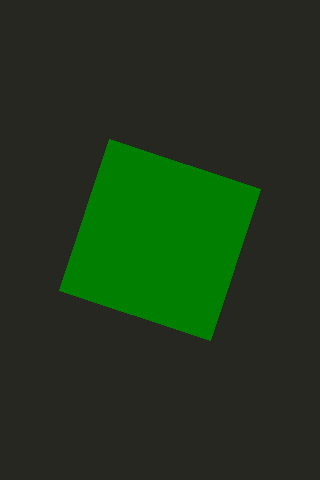用例 - 在 QML 中集成 JavaScript#
如何在 QML 应用程序中集成 JavaScript 代码的示例
可以将 JavaScript 代码轻松集成到 QML 中,以提供 UI 逻辑、命令式控制或其他好处。
使用 JavaScript 表达式作为属性值#
可以将 JavaScript 表达式用作 QML 中的绑定。例如
Item { width: Math.random() height: width < 100 ? 100 : (width + 50) / 2 }
请注意,函数调用,如 Math.random(),除非它们的参数发生变化,否则不会重新评估。因此,绑定到 Math.random() 将是随机数字一次,不会重新评估,但如果以其他方式更改宽度,则高度绑定将重新评估以考虑这一点。
在 QML 中添加 JavaScript 函数#
可以在 QML 项目中声明 JavaScript 函数,如下例中所示。这允许您使用组 ID 调用方法。
import QtQuick Item { id: container width: 320 height: 480 function randomNumber() { return Math.random() * 360; } function getNumber() { return container.randomNumber(); } TapHandler { // This line uses the JS function from the item onTapped: rectangle.rotation = container.getNumber(); } Rectangle { color: "#272822" width: 320 height: 480 } Rectangle { id: rectangle anchors.centerIn: parent width: 160 height: 160 color: "green" Behavior on rotation { RotationAnimation { direction: RotationAnimation.Clockwise } } } }
使用 JavaScript 文件#
可以使用 JavaScript 文件来从 QML 文件中提取逻辑。为此,首先按照以下示例将函数放入 .js 文件中。
// myscript.js function getRandom(previousValue) { return Math.floor(previousValue + Math.random() * 90) % 360; }
然后,将文件导入任何需要使用该函数的 .qml 文件中,如下面的示例 QML 文件所示。
import QtQuick import "myscript.js" as Logic Item { width: 320 height: 480 Rectangle { color: "#272822" width: 320 height: 480 } TapHandler { // This line uses the JS function from the separate JS file onTapped: rectangle.rotation = Logic.getRandom(rectangle.rotation); } Rectangle { id: rectangle anchors.centerIn: parent width: 160 height: 160 color: "green" Behavior on rotation { RotationAnimation { direction: RotationAnimation.Clockwise } } } }
有关 QML中所用 JavaScript 引擎的详细信息以及与浏览器 JS 的区别,请参阅 QML 文档中 JavaScript 表达式的完整文档。